Integrating Android Apps into Windows 11: A Comprehensive Guide
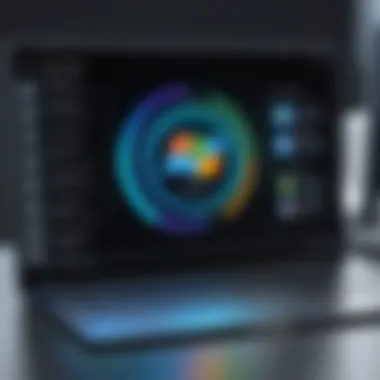
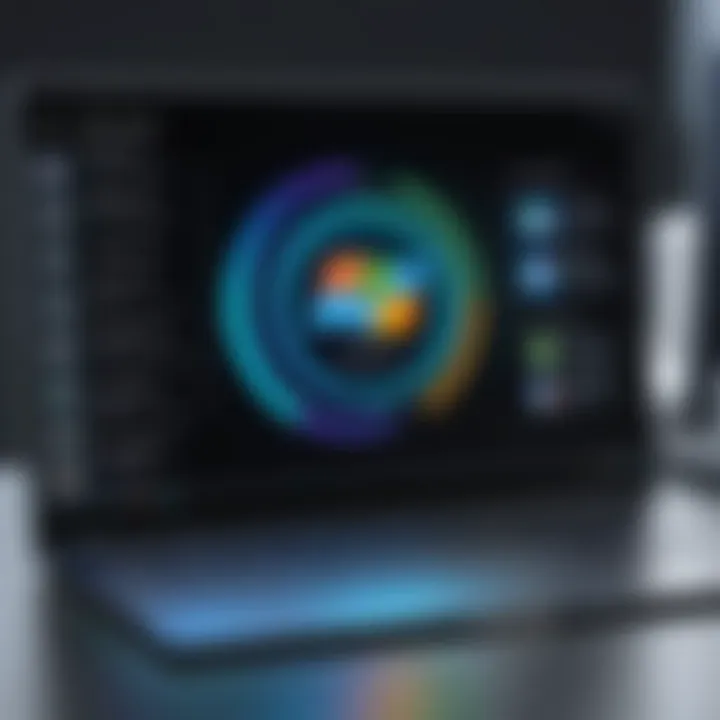
Intro
The emergence of mobile applications has transformed how we use technology. Android applications have gained significant popularity. Windows 11 provides an advanced environment for integrating these Android apps directly. This guide aims to explore the various methods for achieving such integration. It will help users navigate through the details, from installation and system requirements to troubleshooting.
Overview of the Technology
Understanding the technical landscape is crucial for a smooth integration process. Windows 11 supports a variety of Android applications. This feature is essential for those who depend on mobile apps for daily tasks or entertainment.
Key specifications
For integrating Android apps into Windows 11, specific technical requirements should be considered. First, users need an appropriate Windows 11 version that supports this functionality. Additionally, some form of virtualization must be enabled in the BIOS settings.
Here are some key specifications:
- Processor: A minimum of 64-bit processor is required.
- RAM: At least 8 GB of RAM for smooth performance.
- Storage: SSD is recommended for faster loading times.
- Graphics: DirectX 12 compatible graphics for optimal performance of graphics-intensive apps.
Unique selling points
The main advantages of using Android apps on Windows 11 are versatility and accessibility. Users can access favorite mobile applications without switching devices. The streamlined experience allows for a more productive workflow.
Another significant point is the ability to run Android apps in a windowed mode. This feature enhances multitasking capabilities.
"Windows 11 opens doors to a seamless integration of mobile and desktop experiences, enhancing productivity and user satisfaction."
Installation Methodologies
To install Android apps on Windows 11, there are several methodologies. Each method has its own set of steps and considerations. It is important to understand the options available based on individual needs.
One common approach is using the Amazon Appstore available in the Microsoft Store. This official option provides a broad range of Android apps.
Another route involves utilizing emulators, such as BlueStacks or Nox Player. These emulators allow users to run Android applications on Windows without limitations.
System Requirements for Installation
Regardless of the method chosen, knowing system requirements is paramount.
- Storage for Apps: Ensure sufficient space for app installation.
- Internet Connection: A stable connection is often needed for downloading apps.
- Windows 11 Requirements: User must be on Windows 11 build 22000 or later.
Troubleshooting Techniques
Sometimes, users may run into issues while integrating Android apps. A systematic troubleshooting approach can resolve common problems.
Some common troubleshooting techniques include:
- Check for updates. Ensure Windows and the Android emulator are updated.
- Verify BIOS settings. Make sure virtualization is enabled.
- User Permissions. Sometimes apps need administrative privileges to run.
By following clear steps, many problems can easily be resolved, enhancing the overall user experience.
Closure
Integrating Android apps into Windows 11 presents a unique opportunity to enhance productivity and accessibility. With various methods for installation and troubleshooting, users can adeptly navigate their Android applications on a desktop environment. A well-informed approach enables users to maximize the advantages provided by both platforms, making for a smoother and more efficient computing experience.
Prelude to Android Apps on Windows
The integration of Android apps into Windows 11 signifies a major shift in how users interact with technology. Windows 11 not only brings a new interface but also opens the door to a more versatile computing environment. As consumers increasingly rely on mobile applications, having the capability to access these applications directly from a Windows desktop system enhances productivity and user experience.
Key aspects of this integration include:
- Expanded Accessibility: Windows users can enjoy their favorite Android applications right on their device without needing a separate mobile device.
- Enhanced Productivity: Users can switch between Android and Windows applications seamlessly, creating a more fluid workflow.
- Broader Application Ecosystem: Access to a wider range of applications is a game changer. Mobile applications often provide unique features that can complement desktop software.
This integration allows users to harness the strengths of both platforms effectively. It also represents a significant step forward in the evolution of operating systems, where distinct environments become increasingly connected. Understanding the nuances of this integration will facilitate better usage, troubleshooting, and optimization of Android apps on a Windows platform.
Evolution of Operating Systems
Operating systems have come a long way since their inception. Initially, they were designed to manage hardware and software resources independently. As technology evolved, operating systems became more user-centric. The introduction of mobile operating systems like Android prompted a new wave of development focused on user experience and app functionality.
With Windows 11's incorporation of Android applications, we see a convergence of mobile and desktop experiences. This reflects broader trends in tech, including cloud computing and cross-platform functionality. By allowing Android apps to run on Windows 11, Microsoft acknowledges the importance of flexibility and user choice in today's digital landscape. As users shift towards more mobile solutions, operating systems must adapt.
Importance of Cross-Platform Compatibility
Cross-platform compatibility is no longer a luxury; it is a necessity for today’s consumer. With varied devices being used across different environments, ensuring that applications operate seamlessly on multiple platforms fosters user engagement and satisfaction. The ability to run Android apps on Windows 11 exemplifies this need.
This capability not only enhances user convenience but also broadens the market for developers. Key considerations include:
- User Retention: Users are more likely to continue using applications that transcend platform limitations. When familiar apps are available on a desktop, it reduces the friction associated with switching devices.
- Developer Opportunities: Developers can reach wider audiences by creating applications that are compatible across multiple operating systems. This fosters innovation and creativity.
- Streamlined Workflows: Users can maintain productivity by accessing the same applications regardless of the device in hand. Switching contexts has never been easier.
As technology continues to evolve, cross-platform compatibility will increasingly dictate the success of applications. With Windows 11’s support for Android apps, both users and developers stand to benefit significantly.
Understanding Windows Functionality
Understanding Windows 11 is crucial for anyone looking to integrate Android applications effectively. This operating system, released in 2021, brings new dimensions to user experience, especially through improved capabilities and a redesign focused on usability. With features aimed at enhancing productivity and creativity, Windows 11 provides the ideal framework for running Android apps, whether through native support via the Microsoft Store or via emulators.
Windows 11 is designed for seamless multitasking and better system integration, allowing users to run Android apps alongside traditional desktop applications effortlessly. Recognizing these functionalities will aid users in making informed decisions regarding their computing needs.
New Features and Enhancements
Windows 11 introduces several key enhancements that significantly affect its functionality. Notable features include:
- Revamped User Interface: A centered Start menu and taskbar streamline user interaction. This modern look improves accessibility and caters to both casual and professional users.
- Snap Layouts: This feature allows users to organize windows efficiently by snapping them into predefined layouts. This assists in multitasking, especially when using multiple apps, including Android applications.
- Widgets: Providing personalized content, widgets allow users to quickly access relevant information without disrupting their workflow. This can include notifications from Android apps or other applications that improve user productivity.
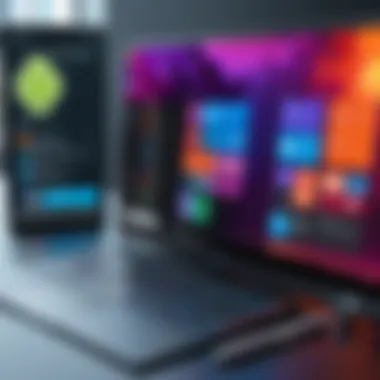
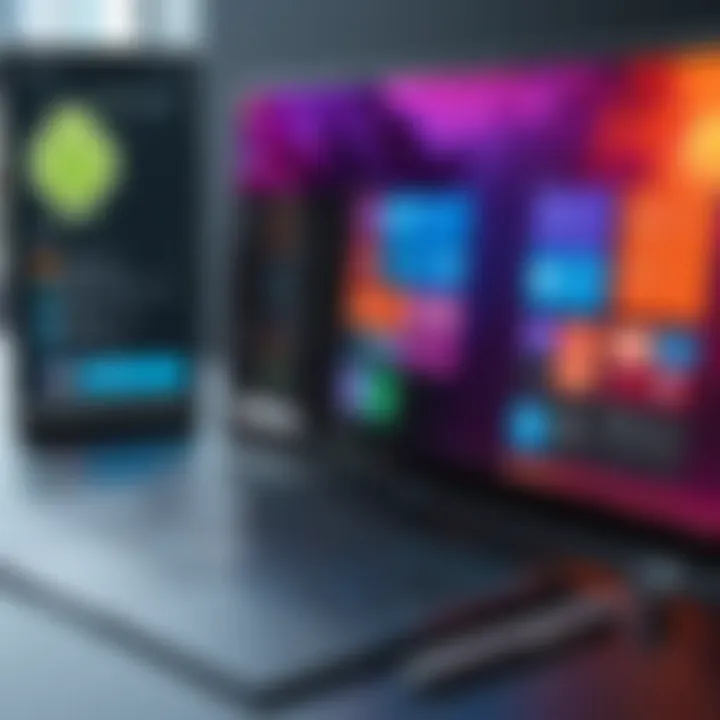
These enhancements bring about not just aesthetic improvements but foundational changes to how applications interact within the operating system.
Integration Support for Android Apps
Windows 11 offers integration support for Android apps in a way that enhances user experience significantly. Through the collaboration between Microsoft and Amazon, users can access Android apps directly from the Microsoft Store. The integration refers to:
- Direct Installation: Unlike traditional methods, users can now install Android apps without third-party tools, making the process straightforward.
- Performance Optimization: The architecture of Windows 11 allows for Android applications to run more smoothly. The performance is optimized to ensure that users can enjoy a responsive experience similar to using native Windows applications.
- Security Features: Windows 11 has built-in security measures. Running Android apps through this operating system can take advantage of these security features, providing users with confidence that their data remains safe.
Overall, Windows 11's design fosters an ecosystem that seamlessly integrates Android functionalities within a familiar desktop environment, making it a powerful platform for diverse application usage.
Microsoft Store Offerings for Android Apps
The integration of Android apps into Windows 11 is greatly facilitated by the Microsoft Store. This platform not only offers a space for users to discover and download various applications but also ensures that these apps are optimized for performance and security in the Windows environment. The Microsoft Store acts as a vital point for proliferation, providing a curated selection of apps which streamline the user experience and eliminate the need for external sources.
The presence of Android apps in the Microsoft Store signifies a shift towards more versatile computing paradigms. It allows users to leverage the multitude of applications available within the Android ecosystem without having to depend on third-party solutions. This directly enhances user engagement and satisfaction, making Windows 11 even more appealing for those looking to bridge the gap between mobile and desktop experiences.
Key benefits of the Microsoft Store offerings include:
- Security Assurance: Applications within the Microsoft Store undergo rigorous checks, ensuring that users download legitimate and safe software.
- Ease of Use: The installation process is greatly simplified, making it accessible for less tech-savvy users as well.
- Updates and Support: Users receive ongoing support and regular updates for the apps they download, helping to keep their systems optimized and secure.
As users explore the offerings within the Microsoft Store, they will find that the integration of Android apps significantly enriches their Windows 11 experience.
Availability of Android Apps on the Microsoft Store
The availability of Android apps on the Microsoft Store is a crucial aspect of this integration. With a growing catalog, users can now find popular apps that were previously exclusive to mobile devices. Leading applications like Instagram, TikTok, and various productivity tools are available directly from the store, allowing seamless access for users.
This integration not only reflects the demand for cross-platform applications but also indicates a strategy by Microsoft to attract more users to Windows 11 by leveraging the familiar Android ecosystem. This includes:
- Diverse Categories: Users can discover a range of apps across categories such as productivity, entertainment, and social media.
- Increased Adoption: As more Android apps become available, Windows users are likely to adopt the operating system for its growing capabilities.
Installation Procedures from the Store
Installing Android apps from the Microsoft Store is designed to be an intuitive process. Users can follow these simple steps to ensure a smooth installation:
- Open the Microsoft Store: Navigate to the app on your Windows 11 device.
- Search for Desired App: Use the search function to find a specific Android app or browse through the categories.
- Select App: Click on the app to view details and read user reviews.
- Install: Hit the install button. The app will begin downloading and installing automatically.
- Launch the App: Once installed, the app will appear in your Start menu, allowing easy access.
The process emphasizes accessibility and efficiency, making it easier for users to tap into the wide array of Android applications available. The unified ecosystem of Windows 11 now allows users to integrate their mobile applications into their daily computing tasks effortlessly.
"With the Microsoft Store facilitating access to Android apps, Windows 11 bridges the gap between desktop and mobile computing seamlessly."
In summary, the Microsoft Store plays a pivotal role in the integration of Android apps into Windows 11. Its offerings ensure a smooth, secure, and user-friendly experience that enhances the overall functionality of the operating system.
Exploring Android Emulators for Windows
The integration of Android applications into Windows 11 is not limited to the Microsoft Store. For users seeking additional options, Android emulators offer a diverse toolkit. These emulators create a virtual environment that allows Android apps to run on Windows. Understanding how to effectively use these emulators broadens the application realm, making it essential for anyone wanting to enhance their digital experience.
Emulators present several significant advantages. First, they provide access to a library of applications that may not be available through the Microsoft Store. Moreover, emulators can facilitate the testing of app functionalities. Developers also benefit from using emulators to simulate different device types and configurations, which helps in optimizing applications for various user scenarios. Additionally, some emulators can enhance the performance of graphic-intensive apps, allowing for a more robust gaming experience or seamless video editing. However, there are also considerations users must bear in mind, such as system resource allocation and potential security vulnerabilities.
Popular Emulators: Overview
When selecting an Android emulator, several options emerge as leading choices in the market.
- BlueStacks: Known for its user-friendliness, BlueStacks is popular among gamers. It offers features tailored for gaming, such as keyboard mapping and multiple instance capabilities.
- NoxPlayer: This emulator is also favored by gamers. NoxPlayer provides a comprehensive toolkit, allowing for script recording and macro settings, which enhances gameplay automation.
- LDPlayer: This is another emulator ideal for gaming. It is lightweight and often noted for its speed and stability.
- Genymotion: This emulator targets developers more than casual users. It is designed for testing applications across various Android versions and devices.
These emulators vary in features and performance. Each serves different user needs, creating opportunities for broader app usage on Windows 11.
Step-by-Step Emulator Installation
Installing an Android emulator on Windows 11 can seem daunting at first, but the process is relatively straightforward. Follow these steps to get started with one of the popular emulators, such as BlueStacks:
- Visit the Official Site: Navigate to the BlueStacks website and download the installer. Ensure that you are getting the latest version for optimal performance.
- Run the Installer: After downloading, double-click the installer file. Follow the on-screen instructions to complete the installation. It may take a few minutes to set up.
- Complete Initial Setup: Once installed, open BlueStacks. You will be prompted to log in with your Google account, which is necessary to access the Google Play Store.
- Download Apps: After completing the setup, you can search for and download apps from the Google Play Store directly within BlueStacks.
- Adjust Settings: Explore the emulator settings to customize performance adjustments. Making tweaks can enhance your experience based on your hardware specifications.
The process is similar across other emulators, though some specifics may vary. It is always good practice to consult the emulator's documentation for detailed guidelines.
System Requirements for Running Android Apps
The integration of Android apps into Windows 11 holds significant potential for enhancing user productivity and experience. However, before users can tap into this potential, understanding the system requirements for running these applications is essential. Ensuring that the system meets these specifications not only facilitates a smoother installation process but also optimizes the overall performance of the apps once they are running. This section aims to delineate the specific requirements, both minimum and recommended, that must be considered to maximize the efficacy of Android apps on Windows 11.
Minimum Requirements
To get started with Android apps on Windows 11, there are several minimum requirements that a system must fulfill. These requirements serve as basic guidelines to ensure that the applications can run at a fundamental level. Here are the key components:
- Processor: A supported Intel processor, preferably with virtualization capabilities (Intel VT-x or AMD-V).
- RAM: At least 8 GB of RAM is necessary. Less RAM may limit the app performance.
- Storage Space: A minimum of 16 GB of free storage is essential for installation and smooth operation units.
- Operating System Version: The device must run Windows 11 with the latest updates installed.
- Graphics: A DirectX 12 compatible graphics or integrated GPU is important, as it enhances visual fidelity.
It is crucial to understand that falling short of these minimum specifications may lead to degraded performance. Users might experience slow loading times or application crashes. Therefore, it is advisable to assess the system specifications before attempting to install Android apps.
Recommended Specs for Optimal Performance
While the minimum requirements allow basic functionality, recommended specifications elevate the experience significantly. Meeting or exceeding these specifications can benefit users through improved responsiveness, faster load times, and enhanced graphical capabilities. The following outlines the recommended specs:
- Processor: A multi-core Intel i5 or equivalent processor to handle complex tasks efficiently.
- RAM: 16 GB or more is suggested for seamless multitasking and better app performance.
- Storage Space: 30 GB or more of available storage ensures sufficient space for app data and updates.
- Operating System Version: Keeping the system updated to the latest version of Windows 11 is crucial for maintaining compatibility and security.
- Graphics: A dedicated graphics card, such as NVIDIA GeForce GTX 1050 or AMD Radeon RX 560, enables better graphics performance and supports demanding applications.
Running Android apps on a system that meets recommended specifications drastically improves the overall user experience.
By adhering to these recommended specifications, users can not only run Android applications more effectively but also ensure longevity in performance as updates and more demanding applications emerge.
User Interface and Experience Considerations
When integrating Android apps into Windows 11, the user interface and experience take center stage. Understanding how these apps interact with Windows 11's unique ecosystem is crucial for a seamless experience. The way users interact with apps affects overall satisfaction and productivity.


App Interaction Differences
Using Android apps on Windows 11 introduces certain interaction differences that users should be aware of. The most noticeable variation comes from the adaptation of touch-focused designs to a traditional mouse-and-keyboard setup.
- Touch Gestures: Many Android apps utilize swipes and gestures, which may not translate perfectly when using a mouse. For example, a simple swipe to refresh may require users to click and drag with precision.
- Window Management: Android apps typically run in a contained environment with limited multitasking abilities. However, in Windows 11, users can utilize features, such as Snap Layouts, for efficient window management. This allows for better organization but may feel different for those used to Android's full-screen applications.
- Notifications: Notifications in Android behave distinctively compared to Windows. Users might find that interactions with notifications from Android apps do not seamlessly integrate into the Windows notification center, creating potential confusion about message origin and urgency.
These interaction differences can impact usability and performance, requiring users to adapt slightly to maximize their efficiency with Android apps integrated into their desktop environment.
Customization Options for Users
Customization becomes vital as users strive to tailor the experience of Android apps on Windows 11. With various tools and features available, users can enhance their interaction with these applications.
- Resizing Windows: Unlike standard Android devices, Windows allows users to resize application windows freely. This flexibility can improve the workflow as users work with multiple apps simultaneously. Adjusting window sizes to fit personal preference is essential in boosting productivity.
- Themes and Appearance: On Windows 11, users can apply themes that can influence how Android apps are rendered. While not all Android apps may fully respect these themes, many will adapt to a certain degree, providing a more cohesive aesthetic.
- Keyboard Shortcuts: Windows supports numerous keyboard shortcuts that can enhance app usage. These shortcuts may not exist in Android, meaning users can save time and effort when navigating between apps on their Windows device.
"Effective use of customization options can significantly impact user satisfaction when operating Android apps on Windows 11."
These customization features help users create a personalized experience, bridging the gap between two operating systems while enhancing productivity and overall satisfaction.
Performance Metrics for Android Apps on Windows
Performance metrics are essential for evaluating how Android applications perform when integrated into Windows 11. The significance of these metrics cannot be overstated, as they provide insights into an app's responsiveness, efficiency, and overall user experience. In a world where multitasking is increasingly common, understanding how well an app operates within the Windows environment becomes crucial for both developers and users. Adopting appropriate metrics allows for tailored optimizations that can enhance functionality and user satisfaction.
Analyzing Speed and Efficiency
Speed and efficiency are core components when assessing the performance of Android apps on Windows. Users expect applications to load quickly and run seamlessly. When an app fails to meet these expectations, it can lead to frustration and decreased productivity.
- Load Time: This is the time taken for an app to start and be ready for use. Reduced load time is necessary to keep users engaged. Tools like PerfView can help developers analyze and optimize load times effectively.
- Response Time: It measures how quickly the app reacts to user inputs, such as taps or swipes. A lagging response can significantly diminish the user experience. Testing can reveal areas of improvement to ensure that actions feel immediate.
- Resource Consumption: Efficient usage of CPU and memory is vital. High resource consumption can lead to slowdowns not just of the app in question, but the entire operating system. Monitoring tools can aid developers in identifying and correcting inefficient resource usage.
"Understanding metrics about an app's speed and efficiency enables developers to make informed decisions leading to better performance."
Regularly evaluating these metrics provides actionable insights. Fine-tuning the app based on performance data can result in a smoother user experience, ultimately encouraging continued use of Android applications on Windows 11. Users benefit from improved efficiency as well as speed, fostering an environment where productivity can thrive.
Graphics Performance Evaluation
Graphics performance is another crucial metric for evaluating Android apps on Windows. As applications become more visually intensive, especially games and creative tools, performance in this area can be a dealbreaker.
- Frame Rate: This is a critical metric for applications that require fluid motion, such as games. Frame rates should ideally be 60 frames per second or higher for optimal performance. A low frame rate results in choppy visuals and can be distracting.
- Rendering Time: This refers to the time it takes for graphics to be processed and displayed. Analysis tools can help pinpoint bottlenecks in rendering, ensuring timely and smooth graphics delivery.
- Resolution Handling: The ability of an app to adjust its performance when run on different resolutions is also important. An app should maintain quality and performance regardless of display size or resolution.
- GPU Utilization: An effective distribution of graphics processing can greatly enhance overall performance. Monitoring GPU utilization helps in figuring out whether the app is making full use of the hardware capabilities available on Windows 11.
Understanding the graphics performance allows for adjustments that can lead to visually stunning applications while maintaining efficiency. Higher graphical fidelity without compromising responsiveness is the goal that developers should strive for in their products.
By closely examining both speed and graphics performance, users and developers can ensure that Android applications operate at peak efficiency in a Windows 11 environment.
Troubleshooting Common Issues
Troubleshooting common issues is a critical aspect of integrating Android apps into Windows 11. This section aims to identify and resolve problems that users might encounter, ensuring a smoother experience. Users may face various challenges during installation and while using these applications. Understanding these issues not only enhances user satisfaction but also improves trust in the platform's capabilities. Successful troubleshooting can also prevent potential frustrations, making the integration experience seamless.
Installation Problems
Installation problems can arise from a variety of factors when trying to run Android apps on Windows 11. This can include compatibility issues, insufficient system resources, or incorrect settings. The following points can help in diagnosing and resolving such problems:
- Check System Requirements: Ensure that your system meets the minimum specifications for both Windows 11 and the Android apps you intend to install. Refer to the manufacturer's recommendations.
- Update Windows: Keep Windows 11 up to date. Updates often contain patches and bug fixes that might resolve installation issues.
- Disable Conflicting Software: Sometimes, antivirus or firewall settings can interfere with the installation process. Temporarily disabling them may allow for successful installation.
- Installation Permissions: Ensure that the application has the necessary permissions. If you are not the administrator of the system, some settings may need adjustment.
- Log Installations: If problems persist, maintaining logs of installation attempts can help diagnose the issue based on patterns observed over time.
Performance Issues and Fixes
Performance issues may surface after installation. Recognizing and remedying these can significantly enhance user experience. Potential performance troubles may include slow loading times, unresponsiveness, or crashes. Users can take several measures to optimize performance:
- Clear Cache and Data: Regularly clear cache and data for smoother operation. Settings in Android apps often have this option available.
- Resource Management: Close other applications running in the background to free up system resources. Windows 11 has robust task management tools that can help monitor this.
- Adjust Graphics Settings: Some apps may allow adjustments to their graphical settings. Lowering graphics quality can improve app performance on lower-end systems.
- Review Updates for Apps: Like Windows, Android apps require occasional updates. Checking for and applying these updates can lead to enhanced performance and stability.
- Look at Device Performance Settings: Make sure the performance settings in Windows 11 are optimized for applications rather than battery saving.
Troubleshooting common installation and performance issues can unlock the full potential of Android apps on Windows 11.
By following these guidelines, users can approach troubleshooting with a defined strategy, transforming potential roadblocks into resolved issues. With awareness of these common problems and solutions, the integration of Android apps into Windows 11 can prove to be a rewarding endeavor.
Security and Privacy Concerns
As users increasingly integrate Android applications into Windows 11, understanding security and privacy concerns becomes paramount. With the convenience of having Android apps accessible on a desktop environment, there are inherent risks involved. Users often interact with sensitive information and services through these applications, making security protocols and safeguards critical.
Emulators and Risks
Using emulators is a common method to run Android apps on Windows 11. However, these emulators can present specific risks. Some emulators may not have adequate security measures, exposing the user's system to malware or unauthorized access. Additionally, not all emulators are regularly updated, which can leave security vulnerabilities unaddressed.
"Security should never be an afterthought, especially when integrating systems that involve personal information."
When choosing an emulator, it is crucial to opt for reputable options that are transparent about their security practices. Popular emulators such as Bluestacks and Nox Player have garnered positive reviews, but always check for the latest updates and developer support to mitigate risks.
Safeguarding Personal Information
Personal data protection is vital when using apps, considering that many Android applications require access to private information such as location, contacts, and storage. To minimize the risk, users should adopt certain practices.
- Review Permissions: Always look at the permissions requested by an app during installation. If an app asks for more access than necessary, it may be wise to reconsider using that app.
- Utilize VPN Services: A Virtual Private Network can provide an additional layer of security when using Android apps on Windows. It helps to encrypt data, thus protecting sensitive information from potential threats.
- Keep Software Updated: Regular updates ensure that security patches are applied, reducing the risk of vulnerabilities being exploited.
- Isolate Usage: If possible, run Android apps on a separate user account in Windows. This approach limits the access that apps have to your sensitive data.
- Educate Yourself: Understanding the risks associated with Android apps can empower users to make informed decisions. Resources from sites like en.wikipedia.org and britannica.com can provide valuable insights.
Keeping these considerations in mind will help users safely navigate the world of Android applications on Windows 11. By prioritizing security and managing privacy effectively, users can enjoy the myriad of functionalities that these apps offer without compromising their personal information.
Alternatives to Using Android Apps
In the evolving landscape of digital applications, the ability to access various functionalities is vital. While Android apps offer unique features, sometimes users might seek alternatives for various reasons such as compatibility issues or specific needs that those apps cannot meet. Exploring alternatives is especially relevant for tech-savvy individuals who wish to maximize their user experience on Windows 11. This exploration acknowledges the importance of flexibility in application use across devices.
Web-Based Alternatives
Web-based applications provide a significant advantage as they do not require installation, which can mitigate performance concerns associated with running Android apps on Windows. These applications run directly in a web browser, allowing for immediate access.
Benefits of Web-Based Applications:
- Accessibility: Users can access these applications from any device with an internet connection, including Windows PCs, tablets, or smartphones.
- No Installation Required: The ease of access means there is no need for lengthy installation processes or dealing with compatibility.
- Cross-Platform Functionality: They often work across multiple operating systems, ensuring users have the same experience no matter what device they are using.

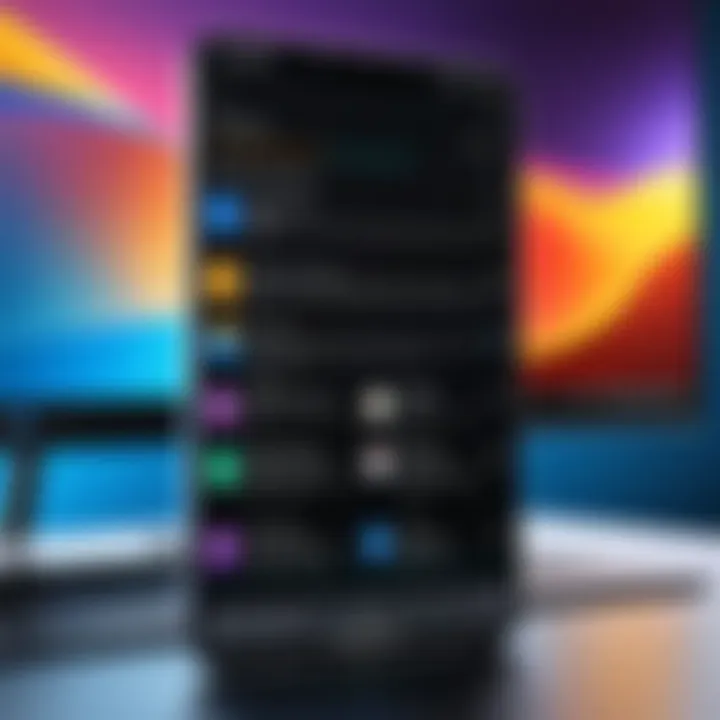
Some notable examples of web-based alternatives include Google Docs for document editing and Trello for project management. Utilizing these tools can enhance productivity while ensuring a seamless user experience without the overhead of Android app integration.
Cross-Platform Applications
Cross-platform applications are another essential category of alternatives that deserve attention. These applications are designed to work seamlessly on multiple operating systems, which means they can function effectively on Windows 11, macOS, iOS, and Android.
Key Considerations for Cross-Platform Apps:
- User Experience: Many cross-platform apps prioritize a consistent user experience across devices, ensuring users can transition easily between their Windows 11 PC and mobile devices.
- Developer Support: Developers often provide updates and support for these applications, ensuring they remain compatible with future operating system updates.
- Resource Efficiency: These applications can often work more efficiently than emulators or virtual machines, thereby preserving system resources and improving performance.
Popular examples of such applications include Slack for communication and Discord for community interaction. By focusing on this type of application, users can optimize their workflows while minimizing any disruptions that may arise from using Android apps on a Windows system.
Future Prospects for Android Apps on Windows
The integration of Android apps into Windows 11 presents a landscape filled with potential. The ability for users to run their favorite Android applications directly within the Windows environment enriches the experience, creating synergies between two major operating systems. As technology continues to evolve, understanding the future prospects of this integration can help users and developers make informed decisions.
Anticipated Developments from Microsoft
Microsoft is continuously innovating, and there are several anticipated developments related to the integration of Android apps. This evolution is driven by consumer demand for a seamless experience across different platforms.
- Better Compatibility: Microsoft is likely to enhance compatibility features. This means smoother performance for Android apps, along with improved responsiveness when switching between app types. The alignment of interfaces among different platforms will be a key focus area.
- Integration with Microsoft Services: Future updates may see deeper integration of Android apps with Microsoft services like Office 365 and OneDrive. This will allow users to share files easily between Android and Windows.
- Updates and Security: Regular updates will ensure that both performance and security are prioritized. Implementing security patches in a timely manner is crucial given the common concerns around data protection.
- Enhanced User Interface: Find more intuitive user interface designs that cater to both touch and mouse inputs may appear. This consideration is significant, as users of tablets or touch-enabled laptops will benefit greatly.
These anticipated developments not only enhance functionality but also solidify Windows 11's position as a cross-platform leader.
Shifting Trends in Consumer Technology
The landscape of consumer technology is dynamic, with trends that shift rapidly based on user preference and technological capabilities. Understanding these shifts can provide insight into how Android apps will further integrate into Windows.
- Increased Mobile Usage: With a rise in mobile usage, many users prefer apps that are versatile enough to operate both on smartphones and desktops. The consumer demand for multifunctionality will drive app developers to optimize their Android applications for Windows.
- Remote Work Culture: The expanding trend of remote work has heightened the need for productivity applications. Android apps that facilitate better communication, collaboration, and management are more relevant than ever.
- Rise of Cloud-Based Applications: Increasing reliance on cloud computing solutions means that users value accessibility. Future Android apps will likely maximize cloud technologies, allowing users to access their applications and data seamlessly across platforms.
- Emphasis on Security Features: Consumer awareness around data privacy is growing. Apps that provide stronger security measures will see more adoption. Microsoft’s commitment to ensuring data security on Windows will significantly influence user choices regarding Android app usage.
To summarize, the future of Android apps integrated into Windows 11 looks promising, driven by innovative changes from Microsoft and shifting consumer trends. These factors will shape the overall accessibility and usability of applications in a cross-platform environment.
The future is not just about technology but about how users interact with it and the experiences they demand.
Case Studies of Successful Integration
In exploring the integration of Android apps into Windows 11, it becomes essential to examine real-world examples that illustrate the practical applications and benefits of this compatibility. Case studies reveal how individuals and organizations utilize Android apps effectively on Windows, demonstrating the various advantages and challenges encountered during integration. They also help to identify the best practices and lessons learned.
User Experiences and Feedback
Understanding user experiences is crucial in assessing the overall success of Android apps on Windows 11. Many users report positive experiences within specific contexts, particularly for productivity and communication tools like Slack or Microsoft Teams. These applications leverage Android functionalities while maintaining a familiar interface for desktop users. Feedback often highlights the seamless syncing of notifications and chat messages between devices, which enhances workflow.
However, there are also noted challenges. Some users encounter issues with app optimization, particularly with games that may not perform as well on a bigger screen or with different input methods. Feedback loops, where developers actively seek and incorporate user suggestions, contribute significantly to performance improvements in these apps. This aligns user expectations with the technical capabilities of the Windows environment.
"My experience with Slack on Windows 11 has been largely positive. The integration allows me to maintain constant communication with my team, but I sometimes struggle with lag when switching between tasks."
— A user from Reddit.com
Anecdotal evidence also points out performance issues specifically related to graphics-intensive Android applications. Users frequently express a desire for enhancements in graphical performance to better utilize Windows 11’s capabilities. Thus, analyzing user feedback provides critical insights into improving the integration process.
Analysis of Usage Patterns
When examining usage patterns, it's clear that certain categories of apps dominate the landscape. Social media, productivity, and communication apps often see more user interaction compared to games. Instagram and Twitter, for instance, are commonly accessed through Android emulators on Windows, highlighting a preference for the mobile experience rather than a full desktop application.
Additionally, user behavior indicates a blend of mobile and desktop usage. Many users often start tasks on their Android devices and complete them on their Windows interface, showcasing a need for fluidity in app interaction. This supports the notion that cross-platform functionality extends beyond mere compatibility; it speaks to the evolving nature of user preferences in tech.
Time spent on various applications varies widely, with productivity apps generally receiving more engagement during work hours while social media apps see spikes in usage outside of typical working hours. Understanding these usage patterns is crucial for developers aiming to optimize their applications for Windows 11.
In summary, case studies of successful integration provide valuable insights into user experiences and behavior. This knowledge enables better app development, improvements, and ultimately enriches the integration of Android apps within Windows 11, catering to the sophisticated needs of tech-savvy individuals.
Tips for Effective Use of Android Apps
Integrating Android applications within the Windows 11 ecosystem can significantly enhance user experience. However, to derive maximum benefits, users must leverage specific strategies. This section aims to articulate methods that can optimize functionality and ensure seamless integration. It delves into essential considerations that will elevate the utility of Android apps and foster a more coherent computing environment.
Maximizing Functionality
To ensure that Android apps operate at their best on Windows 11, users should focus on the configurations and settings that influence overall performance. One key aspect is the app's compatibility with the operating system. Users must verify that their chosen applications are designed to work well with the Windows interface, ensuring smoother navigation and usability.
Here are several points to consider:
- Update Regularly: Keeping both Windows 11 and Android apps updated is crucial. Updates often include performance patches, security enhancements, and new features that can improve efficiency.
- Resource Management: Since Android apps may consume significant resources, it's wise to monitor system performance. Users can do this via the Task Manager to identify apps that may be impacting overall speed negatively.
- Utilize Keyboard Shortcuts: Familiarizing oneself with keyboard shortcuts can streamline operations and facilitate quicker interactions with apps, enhancing user productivity.
"Efficiency in performance is often about the small adjustments made at a user level."
Important Settings to Adjust
Adjusting specific settings can dramatically refine the user experience when running Android apps on Windows 11. Here are essential settings that should be configured:
- Display Settings: Adjusting screen resolution and scaling can help optimize how apps present themselves. Some apps may not scale well, causing visual clutter or unintended overlaps on screens.
- Network Options: Android apps typically require internet access to function correctly. Ensuring a stable and strong network connection can prevent interruptions during usage, especially in apps that need continuous streaming or online access.
- Privacy Settings: Users must review privacy permissions for each app. It's vital to manage which personal data each application can access, providing a balance between functionality and security.
The End and Recommendations
Integrating Android applications into Windows 11 represents a significant shift in how users can experience mobile and desktop ecosystems in tandem. This article has provided a detailed exploration of the mechanisms and considerations behind this integration, emphasizing its relevance in today’s technology landscape. By adopting Android apps on Windows 11, users can enhance their productivity and access a broader range of tools.
Summarizing Key Takeaways
Adopting Android apps on Windows 11 can be a straightforward process if users understand key elements:
- Cross-Platform Compatibility: The ability to run apps designed for different operating systems broadens choices for users, enhancing flexibility.
- Diverse Application Access: Users can tap into a vast library of tools, from productivity apps to entertainment platforms, enriching their computing experience.
- Optimized Performance: With appropriate setup, users can enjoy high-performance applications that function well on Windows 11, provided their devices meet the required specifications.
- User Experience: While interaction differs from traditional Windows applications, understanding these quirks can improve the overall experience.
"Integrating different platforms allows for innovative workflows and expanded functionalities, paving the way for modern computing."
Encouraging Safe Practices
While exploring the realm of Android applications on Windows, it is essential to prioritize safety and ensure a secure user experience. Here are some recommended practices:
- Source of Applications: Install apps from recognized and reliable sources only, such as the Microsoft Store. This reduces the risk of malware and other security threats.
- Frequent Updates: Regularly update both Windows 11 and the installed Android apps. Updates often include security patches that protect against vulnerabilities.
- Privacy Settings: Familiarize yourself with the privacy settings of each application. Understanding what data an app accesses and utilizes is crucial for safeguarding personal information.
- Antivirus Software: Utilize renowned antivirus software for additional security. This acts as a protective layer against potential threats arising from third-party applications.







